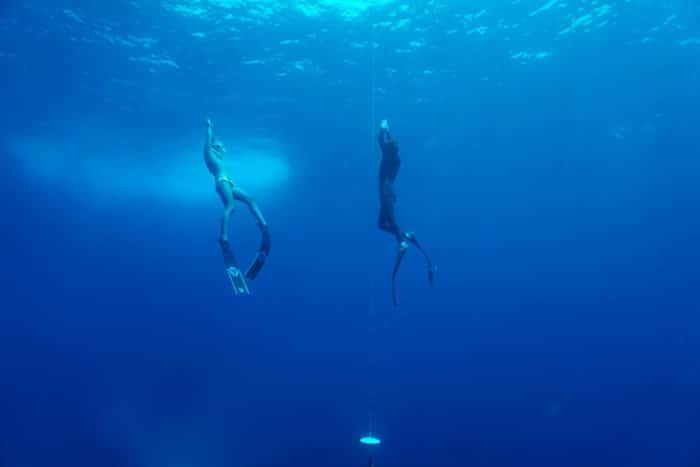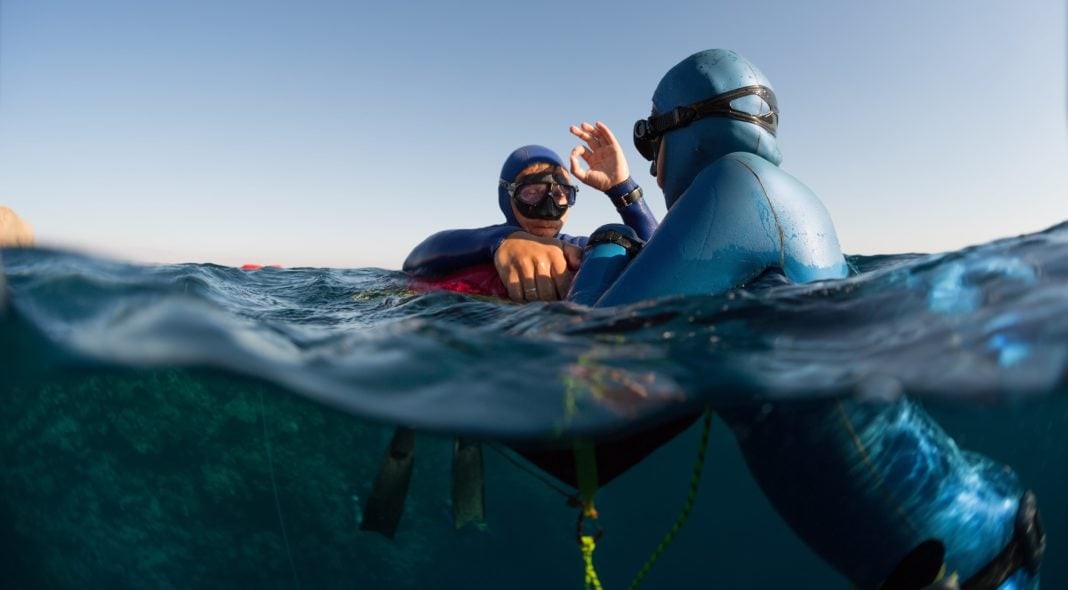March through June is the high season for Freediving courses, but 2020 kept us all homebound in quarantine – far from any immersion, much less interaction with students in a freediving course. Claire and I had pretty much written off teaching any courses in our South Florida region for a while, maybe all of 2020. It had become apparent that it would not be possible to properly mitigate the risks the coronavirus presents while freediving. In fact, a multi-agency report released on May 31, “Freediving in the Time of Novel Coronavirus”, came to that exact conclusion.
Teaching a Freediving course typically entails a lot of direct contact, plenty of strong breathing in proximity before and after a breath-hold, and rescue scenarios where we play the role of the victim. It is an impossible scenario for safe-distancing guidelines. In addition to the risks, the pools we typically used for our confined water skills were still closed as of June 1 and there was no indication that any Miami pools would be reopening soon. Even the beaches had yet to open.
Just as we were committing ourselves to our dry and distant reality, friends of ours contacted us about doing a private class for their teenage sons. Schools were ending and summer vacation was about to begin. We expressed our concerns about the risks of COVID-19, but as we discussed the challenges we realized our friends were just as concerned and had thought of options. The class portion could be taught in a shady outdoor area by a private lap pool. The pool was essentially a single 25-yard long lane ranging in depth from 3 to 9 feet. And even though public pools had yet to open, the CDC website confirmed: “there is no evidence that COVID-19 can be spread to humans through the use of recreational waters”. That takes care of risks underwater, but what about above the water?
The students would be our friends’ two sons along with two brothers from another family whose father was a medical doctor. All four boys had just experienced months of online courses and discussions about the risks presented by COVID-19. Teaching this course started to look very feasible. Claire and I could demonstrate skills on each other, the students would only interact with their sibling, and each household group would maintain their space. We would also have access to a spacious 34’ Crusader for the open water sessions. After discussing every possible risk we all agreed to proceed with the course.
We sent out our welcome email to the students and their parents with the course schedule and the following statement: “in order to do our part to avoid the spread of COVID-19 we have implemented health and safety guidelines and modified our freediving practices”. The course would be over three half-days of class and pool, to allow plenty of time to perfect in-water skills, and two half-days of the ocean. We would extend the pool sessions as needed to ensure our students get their technique down.
We arrived on Day 1 at our open air space by the pool. We had a monitor to project our presentation and our whiteboard for further visual aids, but most importantly we had our masks on. Once the students arrived we determined a seating arrangement that would give us the necessary space to temporarily ditch the masks. So far so good. We covered the history of freediving, breathing, some safety, and gear. During our first pool session, we practiced some basic breathing, safety supervision and rescue skills, and statics. Claire and I demonstrated everything, from a simulated static performance to a do-si-do dance, at a safe distance. Brothers team “A” and brothers team “B” replicated the skills with their own brother. We couldn’t ask for a better scenario. We did not use snorkels on Day 1, and after each skill and breath-hold, the performing freediver made a conscious effort to do breaths away from others. We did ask them to perform a long swim to assess their abilities, and it did dawn on us we could have staggered their starts better to avoid any proximity as they passed each other in opposite directions.
On Day 2 we did some warmup stretches and covered physics and physiology, along with an introduction to Frenzel equalization, before entering the pool for kicking drills and dynamics. It was time to discuss snorkels. We wanted to avoid any strong snorkel blasts spreading droplets. The students either removed their snorkels from their mouth to tilt and drain the snorkel or covered the open top with a hand when they performed a gentle blow to clear. Our exemplary students followed suit with proper technique. After a few rounds of vertical kicking, we set up for dynamics. Each team had its own “A” or “B” kickboard for safety. Each student did a couple of dynamic repetitions before we closed with a review of surface rescue scenarios. We assigned some Frenzel equalization homework, or tubular aerobics, for the evening.
We started Day 3 with some more stretching, a dive visualization, and a review of the equalization technique. As all freedive instructors know, it’s not the students’ breath-hold that is going to determine their depth, it’s their equalization. And the more we resolved any issues on land the less we would have to resolve while bobbing on the surface offshore while trying to maintain a safe distance. We briefed them on open water environments and what to expect during our ocean session and breezed through an overview of local aquatic life which they all knew too well having grown up in Miami. Back in the pool, we introduced them to our float and line rig and how to perform proper entries. We then covered underwater blackout rescue – over and over – until they had it down. Training them to be proficient safeties would be key to our being comfortable at a safe distance during the ocean sessions.
During the first three days of the course, we were keeping close tabs on the weather forecast. It was not looking good. The forecast was still for 15-20 knot winds which are far from ideal conditions for a pleasant freediving experience. Fortunately, we were able to adjust our schedules to plan for a calmer day in which we would do both ocean sessions. We assigned some homework with breathing, equalizations, visualizations, and a review of safe freediving practices before everyone set home for some well-deserved rest.

We met for our scheduled ocean session three days later, one day before Miami beaches were finally scheduled to open after nearly 90 days of closure. We all arrived with face masks or gators on, but you could tell everyone was smiling and feeling good. The weather was perfect – sunny with light winds. The boat ride would be with 8 onboard: 4 students (2 buddy teams), 2 instructors, and 2 crew (Mom and Dad). Everyone came well provisioned, per our advice, with water, snacks, and sun protection. Claire gave the usual briefing – the captain is in charge on board, the instructors are in charge in the water, and so on.
We departed on time and were at the secret blue spot by mid-morning. As briefed, the students started to gear up as Claire and I entered the water to set up our COVID-19 designed rig. We had two floats separated by a 12-foot bar with a third float clipped to a 12-foot line. Only one float would have a descent line and only one buddy team at a time would be on each float. The idea is for one buddy team to do their dives with an instructor escort while the other instructor supervised and the on-deck buddy team watched from the second float on the bar. The buddy teams would alternate between the main floats and the third float would be available for the instructors.
Once the students joined us on the rig we went through our initial weight checks and drills. The students were well prepared. We had little to do or say as they performed dives with perfect form. The extended lectures and pool practices had worked well. Claire led the students through their skills and when possible I would follow them for a photograph. It felt like I was closer to our students than I had been throughout the course, but, oh wait, we are underwater so it only seems closer! And I’m holding my breath!
Teaching during this health crisis presented many challenges, but it also taught us a lot. I have been teaching for years and now realized I had not taken adequate precautions for my health. I was always concerned about my students’ safety. I would recommend that my students not freedive with any kind of congestion, but some had flown in from out of town or had planned to take the course for months and wanted to do what they could. There are a variety of decongestants available to help, but it never occurred to me that whatever they had could be a transmittable virus. We were all sharing a small float, breathing all over each other, and in various scenarios, I was playing the role of the victim so that students could practice their rescues, face clamp, Blow-Tap-Talks, rescue breaths – the whole nine yards. You can’t get less socially distant from new acquaintances than that!
Being able to co-teach with Claire has made a huge difference and allowed us to address many risks. The long-term health issues from COVID-19 are serious, and with the possibility of a second wave, we must be even more cautious. The “Freediving in the Time of Novel Coronavirus” gives excellent advice and I recommend all instructors read it. We must openly discuss the risks of COVID-19, modify our courses to meet recommended guidelines, and only conduct classes if we all accept the risks. This experience not only brought awareness to better hygiene, but it has also made me a better instructor.

